Facial muscles
Table of Contents
Introduction of the facial muscle
The facial muscles, also known as craniofacial muscles, are a group of about 20 flat skeletal muscles lying under the skin of the face and scalp. Most facial muscles originate from the bones or fibrous structures of the skull and radiate to insert on the skin.
Muscle of the Scalp
Occipitofrontalis
Muscles of the Auricle
Situated around the ear
1 Auricularis anterior
2 Auricularis superior
3 Auricularis posterior
These are vestigeal muscles
Muscles of the Eyelids/Orbital Openings
1 Orbicularis oculi
2 Corrugator (Latin to wrinkle) supercilii
3 Levator palpebrae superioris (an extraocular muscle, supplied by sympathetic fibers and the third cranial nerve)
Muscles of the Nose
1 Procerus
2 Compressor naris.
3 Dilator naris
4 Depressor septi
Muscles around the Mouth
1 Orbicularis Oris
2 Buccinator (Latin cheek)
3 Levator labii superioris alaeque nasi
4 Zygomaticus major
5 Levator labii superioris
6 Levator anguli oris
7 Zygomaticus minor
8 Depressor anguli oris
9 Depressor labii inferioris
10 Mentalis (Latin chin)
11 Risorius (Latin laughter)
Muscles of the Neck
Platysma (Greek broad)
Muscles of eyelid/orbital opening
Corrugator supercilii
Origin
The origin of the Corrugator supercilii muscle is from the Medial end of the superciliary arch
Insertion
The Corrugator supercilii muscle inserted on the Skin of mid-eyebrow
Nerve supply
The nerve supply of the Corrugator supercilii muscle is the Temporal branches of the facial nerve (CN VII)
Blood supply
The blood supply of the Corrugator supercilii muscle is the Ophthalmic artery, superficial temporal artery
Action
Vertical lines on the forehead, as in frowning
Orbicularis oculi
a.Orbital part of the Orbicularis oculi muscle, on and around the orbital margin
Origin
The orbital part of the Orbicularis oculi muscle originates from the Medial part of the medial palpebral ligament, frontal process
of maxilla and nasal part of the frontal bone
Insertion
The orbital part of the Orbicularis oculi muscle inserted on the Concentric rings returns to
the point of origin.
Action
Orbicularis oculi muscle Protects the eye from bright light, wind, and rain. Cause forceful closure of eyelids
b. Palpebral part, in the lids
Origin
The Palpebral part of the Orbicularis oculi muscle origin from the Lateral part of the medial palpebral ligament
Insertion
The Palpebral part of the Orbicularis oculi muscle inserted on the Lateral palpebral raphe
Action
Closes lids gently while blinking and sleeping
c. Lacrimal part, lateral and deep to the sac of lacrimal
Origin
The Lacrimal part of the Orbicularis oculi muscle originate ofrom the Lacrimal fascia and posterior
lacrimal crest, forms sheath for lacrimal sac
Insertion
The Lacrimal part of the Orbicularis oculi muscle Pass laterally in front of tarsal plates of eyelids to the
Lateral palpebral raphe
Action
It Dilates the lacrimal sac for sucking lacrimal fluid into the sac, directs lacrimal puncta into Lacus lacrimalis; supports the lower lid
Nerve supply
The nerve supply of the Orbicularis oculi muscle is the Temporal and zygomatic branches of the facial nerve (CN VII)
Blood supply
The blood supply of the Orbicularis oculi muscle is three branches of the external carotid artery: maxillary, superficial temporal, and facial arteries. The ophthalmic artery, a branch of the internal carotid artery, also supplies the Orbicularis oculi muscle.
Muscles around the nasal opening
Procerus
Origin
The Procerus muscle originates from the Nasal bone and upper part of lateral nasal cartilage
Insertion
The Procerus muscle is inserted on the Skin of the forehead between eyebrows and on the bridge of the nose
Nerve supply
the nerve supply of the Procerus muscle is the temporal, lower zygomatic, or buccal branches of the facial nerve (CN VII).
Blood supply
the blood supply of the Procerus muscle is the angular and lateral nasal branches of the facial artery.
Action
The Procerus muscle Causes transverse wrinkles
Compressor naris
Origin
The Compressor naris muscle originates from the Maxilla just lateral to the nose
Insertion
The Compressor naris muscle inserted on the Aponeurosis across the dorsum of the nose
Nerve supply
The nerve supply of the Compressor naris muscle is the facial nerve (7th cranial nerve).
Blood supply
The blood supply of the compressor naris muscle is the branches of the facial artery and the infraorbital branch of the maxillary artery.
Action
Nasal aperture compressed
Dilator naris
Origin
The Dilator naris muscle originates from the Maxilla over the lateral incisor
Insertion
The Dilator naris muscle inserted on the alar cartilage of the nose
Nerve supply
The nerve supply of the Dilator naris muscle is the buccal branch of the facial nerve
Blood supply
The blood supply of the Dilator naris muscle is the Lower branch of the facial artery.
Action
Nasal aperture dilated
Depressor septy
Origin
The Depressor septy muscle originated from the Maxilla over the medial incisor
Insertion
The Depressor septy muscle is inserted on the Lower mobile part of
nasal septum
Nerve supply
The nerve supply of the depressor septi muscle is the buccal branch of the facial nerve (CN VII).
Blood supply
The blood supply of the Depressor septy muscle is the superior labial branch of the facial artery.
Action
Nose pulled inferiorly
Muscles around the lips
Orbicularis Oris
a.Intrinsic part, deep stratum, very thin sheet
Origin
The Intrinsic part of the Orbicularis oris muscle originates from the Superior incisivus, from the maxilla; inferior incisivus, from the mandible
Insertion
The Intrinsic part of the Orbicularis oris muscle is inserted at the Angle of the mouth
Action
The Orbicularis oris muscle causes Closes lips and protrudes lips, numerous extrinsic muscles make it most versatile for various types of grimaces
b. Extrinsic part, two strata, formed by converging muscle
Origin
Thickest middle stratum derived from buccinator muscle; thick superficial stratum, derived from elevators and depressors
Insertion
The Extrinsic part of the Orbicularis oris muscle inserted on the Lips and the angle of the mouth
Nerve supply
the nerve supply of the orbicularis oris is the buccal and mandibular branches of the facial nerve (CN VII).
blood supply
The blood supply of the orbicularis oris muscle is mostly derived from the superior and inferior labial branches of the facial artery, mental and infraorbital branches of the maxillary artery, and the transverse facial branch of the superficial temporal artery.
The muscle of the cheek
Buccinator
Pierced by- Parotid duct and Buccal branch of the mandibular nerve
- Origin
The upper fibers of the Buccinator muscle originate from the maxilla opposite molar teeth
Insertion
The upper fibers of the Buccinator muscle inserted straight into the upper lips
- Origin
The Lower fibers of the Buccinator muscle originate from the mandible, opposite molar teeth
Insertion
The Lower fibers of the Buccinator muscle inserted straight into the lower lip
- Origin
The Middle fibers of the Buccinator muscle originated from the pterygomandibular raphe
Insertion
Middle fibres decussate
Nerve supply
The nerve supply of the Buccinator muscle is the buccal branch of the facial nerve (VII cranial nerve)
Blood supply
The blood supply of the buccinator muscle is mainly from the buccal artery, a branch of the maxillary artery; and some branches of the facial artery.
Action
Flattens cheek against gums and teeth
prevents accumulation of food in the vestibule.
This is the whistling muscle
Levator labii superioris
alaeque nasi
Origin
The Levator labii superioris muscle originates from the frontal process of the maxilla
Insertion
The Levator labii superioris muscle inserted on the Upper lip and alar cartilage of the nose
Nerve supply
the nerve supply of the Levator labii superioris is the zygomatic and buccal branches of the facial nerve (CN VII).
Blood supply
The blood supply of the Levator labii superioris muscle is provided by the facial artery and infraorbital branch of the maxillary artery.
Action
Lifts upper lip and dilates the nostril
Zygomaticus major
Origin
The Zygomaticus major muscle originated from the Posterior aspect of lateral the surface of the zygomatic bone
Insertion
The Zygomaticus major muscle inserted on the Skin at the angle of the mouth
Nerve supply
The nerve supply of the Zygomaticus major is the zygomatic and buccal branches of the facial nerve (CN VII).
Blood supply
The blood supply of the Zygomaticus major is mainly supplied by the superior labial artery that branches off the facial artery.
Action
Pulls the angle upwards and laterally as in smiling
Levator anguli
Origin
The Levator anguli muscle originates from the Maxilla just below the infraorbital foramen
Insertion
The Levator anguli muscle is inserted on the Skin at000 the angle of the mouth
Nerve supply
The nerve supply of the Levator anguli muscle is the Zygomatic and buccal branches of the facial nerve (CN VII)
Blood supply
The Blood supply of the depressor labii inferioris muscle comes from the superior labial branch of the facial artery and the infraorbital branch of the maxillary artery.
Action
Elevates the angle of the mouth, and forms the nasolabial groove
Zygomaticus minor
Origin
The Zygomaticus minor muscle originated from the Anterior aspect of the lateral surface of the zygomatic bone
Insertion
The Zygomaticus minor muscle inserted on the Upper lip medial to its angle
Nerve supply
the nerve supply of the Zygomaticus minor muscle is the zygomatic and buccal branches of the facial nerve (CN VII).
Blood supply
The blood supply of the zygomaticus minor muscle is the superior labial branch of the facial artery.
Action
Elevates the upper lip
Depressor anguli oris
Origin
The Depressor anguli oris muscle originates from the Oblique line of the mandible below the first molar, premolar, and canine teeth
Insertion
The Depressor anguli oris muscle is inserted into the skin at the angle of the mouth and fuses with orbicularis oris
Nerve supply
The Depressor anguli oris receives motor innervation from marginal mandibular and buccal branches of the facial nerve (CN VII).
Blood supply
The blood supply of the Depressor anguli oris is by the inferior labial arteries and mental arteries, which are branches of the facial artery and maxillary artery, respectively. The venous blood is drained through the facial vein into the internal jugular vein(IJV).
Action
Draws angle of the mouth downwards and laterally
Depressor labii inferioris
Origin
The Depressor labii inferioris muscle originated from the Anterior part of the oblique line of the mandible
Insertion
The Depressor labii inferioris muscle inserted on the lower lip at the midline fuses with muscles from the opposite side
Nerve supply
The nerve supply of the Depressor labii inferioris muscle is the mandibular branch of the facial nerve (CN VII).
Blood supply
The blood supply of the depressor labii inferioris muscle is the inferior labial branch of the facial artery and the mental branch of the maxillary artery.
Action
Draws lower lip downward
Mentalis
Origin
The Mentalis muscle originates from the Mandible inferior to incisor teeth
Insertion
The Mentalis muscle inserted Skin of the chin
Nerve supply
The nerve supply of the Mentalis muscle is the mandibular branch of the facial nerve (CN VII).
Blood supply
The blood supply of the Mentalis muscle is the Inferior labial branch of the facial artery and the mental branch of the maxillary artery.
Action
Elevates and protrudes lower lip as it wrinkles skin on the chin
Risorius muscle
Origin
The Risorius muscle originates from the Fascia on the masseter muscle
Insertion
The Risorius muscle inserted on the Skin at the angle of the mouth
Nerve supply
The nerve supply of the Risorius muscle is the buccal branch of the facial nerve (CN VII).
Blood supply
The blood supply of the Risorius muscle is the superior labial artery, given off by the facial artery as it passes deep to the risorius and superficial to the buccinator muscle. Venous blood is drained by the facial vein, also running deep to the risorius muscle; and the transverse facial vein.
Action
The Risorius muscle causes Retraction of the angle of mouth
Muscles of the neck
Platysma
Origin
Upper parts of pectoral and deltoid fasciae
Fibers run upwards and medially
Insertion
Anterior fibers are inserted to the base of the mandible; posterior fibers are inserted into the skin of the lower face and lip and may be continuous with the risorius
Nerve supply
The nerve supply of the platysma is the cervical branch of the facial nerve (CN VII). In addition, it receives proprioceptive nerve supply from the transverse cervical nerve.
Blood supply
The blood supply of the platysma is the submental branch of the facial artery as well as the suprascapular branch of the thyrocervical trunk.
Action
Releases pressure of skin on the subjacent veins; depresses mandible; pulls the angle of the mouth downwards as in horror or fright
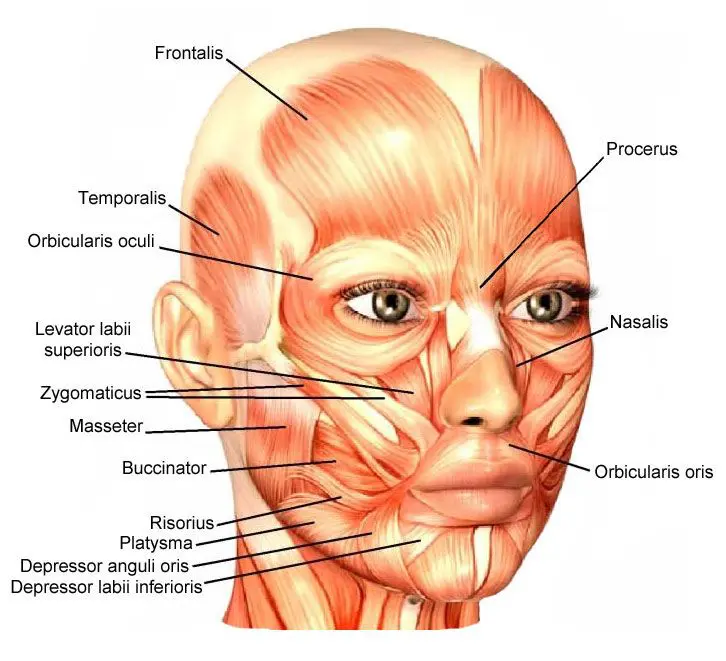
Clinical significance of the facial muscle
Bell’s palsy
Bell’s palsy is a condition that causes a temporary weakness or paralysis of the muscles of the face. It can occur when the nerve which controls your facial muscles becomes inflamed, swollen, or compressed.
Autoimmune disease
Diseases such as Guillain-Barré syndrome(GBS) or multiple sclerosis(MS)can cause facial palsy over time.
Head and neck cancer
In head and neck cancer, a growing tumor can interfere with the function of the muscle of the face over time.
Infection
A bacterial or viral infection can cause inflammation of the facial nerve and problems in the function of the muscles of the face. Examples include infections of the ear, Lyme disease, or Ramsay-Hunt syndrome.
Facial trauma
such as a blow to the head or car accident, which can damage the facial nerve and facial muscles.
Stroke
Strokes cause sudden facial weakness or paralysis.
Exercise of the facial muscle
Eye exercise
Raise your eyebrows up and down. You can use your fingers to lift the affected side eyebrow.
Look down and close your eye while gently massaging the affected side eyelid and eyebrow.
Alternate opening your eyes wide and then gently squeeze them shut.
Mouth exercise
Show your teeth
Gently pucker your lips and then relax.
lift each corner of your mouth individually, one at a time. You may use your fingers to help lift up the affected side.
Stick your tongue out and then aim it down toward your chin.
Nose and Cheek Exercises
By use of your fingers, gently push up the skin next to your nose on the affected side while trying to wrinkle your nose.
Try to scrunch up your face, focusing on the cheeks and nose.
Flare your nostrils and try to take some deep breaths from your nose. You can cover your normal nostril to force the affected muscles to work harder.
Puff up your cheeks and blow the air outside.
Repeat all these exercises 10 times in 3 sets.

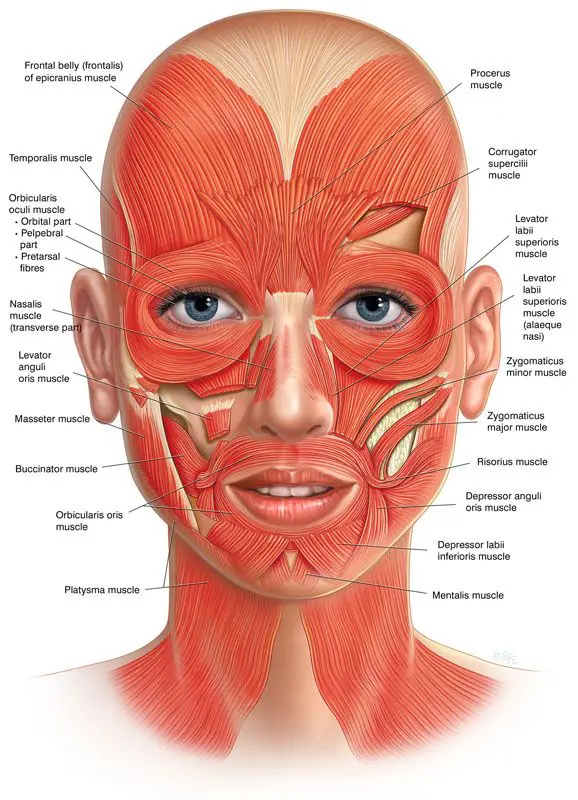
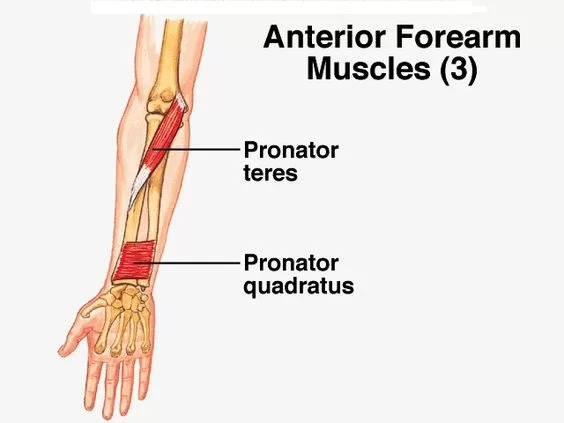
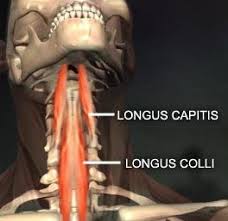
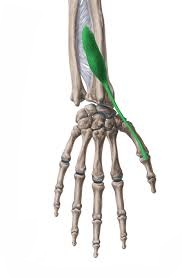
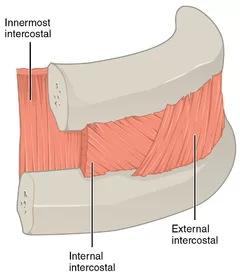
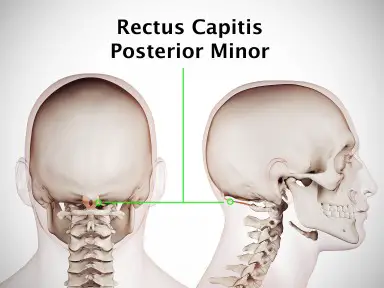
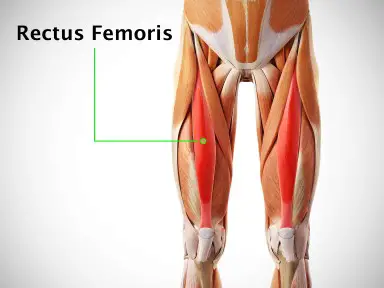
3 Comments